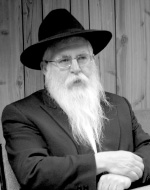Translated and presented by Boruch Merkur
Following the histalkus of the Rebbe Rayatz, the Rebbe MH”M proclaimed that the Rebbe remains alive as before. * Source materials on this topic, compiled by Rabbi Majeski in Likkutei M’koros. (Translations appear in bold. Underlining is the author’s emphasis.)
 In the address said in honor of the Rebbe Rayatz’s Shloshim, on 10 Adar, the Rebbe MH”M tells of how the Rebbe Rayatz’s doctor felt that he had no business being his doctor, for from a medical perspective, he “cannot understand the corporeal life of the Rebbe.”
In the address said in honor of the Rebbe Rayatz’s Shloshim, on 10 Adar, the Rebbe MH”M tells of how the Rebbe Rayatz’s doctor felt that he had no business being his doctor, for from a medical perspective, he “cannot understand the corporeal life of the Rebbe.”
The Rebbe explains the nature of this enigma:
The truth is that the Rebbe’s life is spiritual life: “The life of a tzaddik is not physical life but spiritual life” (Tanya Igeres HaKodesh siman 27).
From this it is understood that with regard to the Rebbe, there is no distinction between his previous status and his current status.
Even now, the Rebbe is with us physically.
And the means of hiskashrus to the Rebbe (mentioned earlier) – i.e., studying his maamarim, etc. – remain in full force.
(Ibid 17)
On Shabbos Parshas Tetzaveh of that year, the Rebbe MH”M came out in protest against the “wild” claims about the Rebbe Rayatz’s histalkus:
Those who say that the “histalkus” means that the Rebbe has “passed away” from us are unruly individuals, who don’t know what they’re talking about.
Indeed, the Rebbe explains, the Rebbe Rayatz elucidated this very term in the maamer “Basi L’Gani,” which was to be given out on Yud Shvat of that year, and turned out to be the day of his histalkus:
The Rebbe explains the saying of the Zohar, “When the Forces of Evil are overcome, the glory of the Alm-ghty is istalek (exalted) in all the worlds.” Would this person translate “istalek” here in the literal sense as well, G-d forbid?!
The Rebbe explains that “the glory of the Alm-ghty is istalek” refers to the manifestation of G-dly light at an extremely lofty level, the level of Sovev Kol Almin, Transcending All Worlds. This manifestation is called “histalkus” because it is at the level of “exaltedness.” From this it is understood that the same meaning applies to the “histalkus” of the Rebbe. […]
Nevertheless, we want and need the Rebbe to be [present in this world in a way that we can perceive him] in the simple sense, “below ten handbreadths”…
The father of the Rebbe Rashab, nishmaso Eden, the Rebbe Maharash, asked his father, the Rebbe the Tzemach Tzedek, in connection with the year that was said to be a “keitz” (a date predicted to be the end of exile): How is it possible that Moshiach did not come? The Tzemach Tzedek answered: Likkutei Torah was published [in that year]! [That is, the revelation of such an important work, which brings G-dly concepts into the realm of human understanding, is tantamount to the coming of Moshiach!] The Rebbe Maharash replies, saying to his father, the Tzemach Tzedek: But we want and need Moshiach in the literal sense, “below ten handbreadths”!
(Ibid 18)
In a letter dated the 25th of Adar 5710, in preparation for Beis Nissan, the Rebbe MH”M specifies two themes of the day: 1) The day of the hilula, the histalkus, of the Rebbe Rashab, and 2) since his position is an inheritance, it is automatically transferred to his only son, the Rebbe Rayatz, “nasi and leader of our generation.”
When it comes to an anniversary of an event, the qualities particular to that original event recur. Naturally, thirty years after the histalkus of the Rebbe Rashab, he has ascended thirty levels, for as our Sages teach, the righteous go from strength to strength, even after their histalkus. At the same time, it is said that “The righteous who pass on are present in all the worlds” – even in the physical world – “more so than when they were alive.” Thus, the influence that extends to his adherents constantly rises higher and higher, and in order for it to be properly received and absorbed by the Chassidim, their “vessels,” i.e., their faculties (presumably their minds and hearts), must be correspondingly purified.
It is, therefore, incumbent upon every Chassid to strengthen his hiskashrus to the Rebbe in accordance with the ways which he has guided us – in his letters, his sichos, and his maamarim – with greater strength and fortitude.
Also, each person must contemplate and implant in his mind and heart the fact that the shepherd – our nasi, my revered father-in-law, the Rebbe הכ’’מ – did not desert his flock, G-d forbid; he still stands and serves in holiness to protect them and provide for all their needs, both materially and spiritually.
[The Rebbe’s signature]
(Ibid 19)